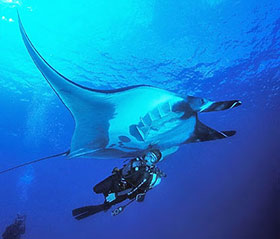 Talking about marine biodiversity means talking about Indonesia, says CORAL Triangle Regional Manager Naneng Setiasih: the largest archipelago in the world with 17,500 islands, Indonesia also has the highest marine biodiversity in the world, including migratory species like the manta ray.
Talking about marine biodiversity means talking about Indonesia, says CORAL Triangle Regional Manager Naneng Setiasih: the largest archipelago in the world with 17,500 islands, Indonesia also has the highest marine biodiversity in the world, including migratory species like the manta ray.
Indonesia recently declared three million square kilometers of its seas as a manta sanctuary. “The key for managing highly migratory species is to assure that we protect them not only in [specific] sites, but also along their migratory routes,” says Nan. She adds that to truly protect biodiversity, we also need to protect connections between islands—including coral reefs—to make sure corals can regenerate and replenish themselves after events like mass bleachings.
Agus Darmawan, Director of Conservation for Areas and Fish Species at the Ministry of Marine Affairs and Fisheries, points out that along with protecting mantas comes the responsibility of helping communities whose livelihoods are impacted by conservation regulations. CORAL and our partners are collaborating with national and local governments to help socialize new CITES regulations that regulate trade of some species of mantas and sharks. We have begun working with the community in Lamakera village, arguably the biggest artisanal manta fishery in the world. Over the years, residents there have seen their catch decline dramatically and have become more willing to support new regulations. The community, CORAL, and our partners are creating a plan for developing alternative livelihoods that would benefit both the community and the environment.
